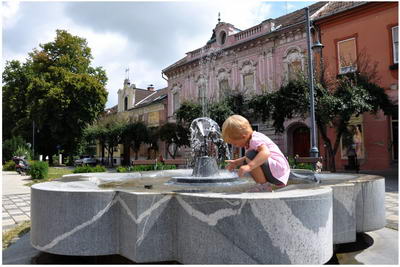Szentgotthárd
 Szentgotthárd is located in the south-western corner of Hungary, in the gate of the Region Őrség, at the confluence of River Rába and River Lapincs. As the centre of the “Vendvidék” it is the fastest developing town in County Vas. Its population is mainly Hungarian, but a significant number of Slovenians and German-speaking people live there as well.
Szentgotthárd is located in the south-western corner of Hungary, in the gate of the Region Őrség, at the confluence of River Rába and River Lapincs. As the centre of the “Vendvidék” it is the fastest developing town in County Vas. Its population is mainly Hungarian, but a significant number of Slovenians and German-speaking people live there as well.
The settlement was founded by King Béla III in 1183, when he settled French Cistercian monks here, building a monastery for them. The monastery was named after Bishop Saint Gotthard of HILDES HEIM.
Next to the monastery, a farmstead was created, where feudalistic agricultural system flourished until 1350. The settlement was owned by the Széchy Family for 300 years. Its fortress, surrounded by a moat, was built by Palatine Széchy Miklós in 1391, then by the Zrínyis and Batthyánys.
Both the monastery and the fortress was blown up during the Bocskai Uprising by the Austrians, thereby the monastic life disappeared.
 The battle of Szentgotthárd against the Turks in 1664 had an effect not only on the politics of the country but also that of the whole Europe. Imperial General Raimondo Montecuccoli joined battle here with the Turks under the command of Grand Vizier Ahmed Köprülü marching towards Vienna. The crucial moment of the seven-hour fight was when many fleeing Turks drowned in the River Rába, which was swollen because of a large rainstorm. Unfortunately, in the course of the peace treaty of Vasvár Hungary was not able to take advantage of the benefits stemming from its victory.
The battle of Szentgotthárd against the Turks in 1664 had an effect not only on the politics of the country but also that of the whole Europe. Imperial General Raimondo Montecuccoli joined battle here with the Turks under the command of Grand Vizier Ahmed Köprülü marching towards Vienna. The crucial moment of the seven-hour fight was when many fleeing Turks drowned in the River Rába, which was swollen because of a large rainstorm. Unfortunately, in the course of the peace treaty of Vasvár Hungary was not able to take advantage of the benefits stemming from its victory.
 After the railway line towards Graz was completed in 1873, the industrialisation of Szentgotthárd started. The town got into a fast connection with the more advanced Styrian province and the Little Hungarian Plain. This development led to an incredibly fast economic and social growth in Szentgotthárd at the end of the 1800s. Factories, plants were established one after another (Toy Factory, Tobacco Factory, Watch Factory, Silk Weaving Factory, and Scythe Factory). The economic development was followed by changes in society: educational and health care institutions were established, civil society organisations strengthened. By the end of the first decade of the 20th century, Szentgotthárd became a bustling small town, it had the county's most developed industrial structure.
After the railway line towards Graz was completed in 1873, the industrialisation of Szentgotthárd started. The town got into a fast connection with the more advanced Styrian province and the Little Hungarian Plain. This development led to an incredibly fast economic and social growth in Szentgotthárd at the end of the 1800s. Factories, plants were established one after another (Toy Factory, Tobacco Factory, Watch Factory, Silk Weaving Factory, and Scythe Factory). The economic development was followed by changes in society: educational and health care institutions were established, civil society organisations strengthened. By the end of the first decade of the 20th century, Szentgotthárd became a bustling small town, it had the county's most developed industrial structure.
One of the driving forces of the development in Szentgotthárd was Széll Kálmán, who supported the ideas first as the Member of Parliament for the region, then as a Minister and Prime Minister.

